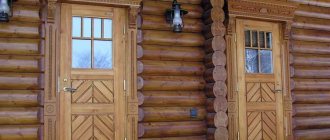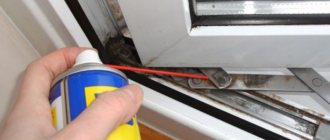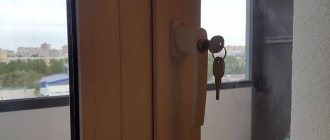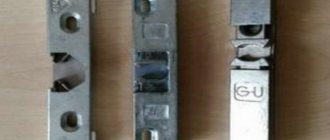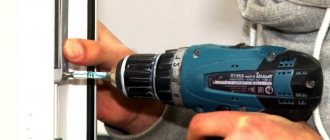It would seem that it is worth trying to insulate a plastic balcony door, because modern technology ensures good quality and precision manufacturing of the door frame, fittings and awnings. All this is correct. But if you use a household thermal imager or simply raise your hand to the balcony door in severe frost, then there will be no doubt: it is necessary to insulate, and preferably professionally, since approximately 80% of the heat from the room leaves through the door and window openings.
Modern metal-plastic will also have to be insulated in due course.
Reasons why cold gets into the apartment
Before trying to insulate a balcony door, you need to understand the reasons why heat escapes from the room. It all depends on how old the doors are, how often they are used, and what condition they are in.
A sample list of reasons is as follows:
- Violation of the integrity of the seal, both on the glass and around the perimeter of the door leaf;
- Worn door fittings, primarily the locks that press the door to the frame, and the canopies that hold the door leaf;
- Deterioration in the thermal insulation qualities of a double-glazed window; as the structure ages, the thermal resistance of the two-chamber system decreases, and accordingly, more heat is removed directly through the glass in the balcony door.
Important! About half of the heat can escape not through the door to the balcony, but through the cracks in the frame. Therefore, the first thing you need to do is inspect the entire opening to the balcony; perhaps there are quite large gaps hidden under the peeling plaster or plasterboard lining.
In winter, they can be detected by the dampness of the surface of the walls adjacent to the exit to the balcony. But it is worth remembering that, in addition to cracks, the cause of heat loss may be the lack of insulation of wall slopes. This is the most common reason for cold rooms with balconies, since builders believe that it makes sense to insulate slopes and insulate them to the door of a loggia or balcony only if directly indicated by the customer or future owner of the apartment.
Option for external insulation of slopes of a wooden frame
Advice from professionals
It is advisable to think about protection from drafts even at the stage of installing a plastic or metal door on the balcony. The most common cause of drafts is insufficiently sealed plastic slots and the choice of a cold profile for aluminum. You should not save on materials or pay for the work of good specialists. As a result, costs will only increase due to the need to seriously reconstruct the plastic or metal glazing of the balcony.
Insulation of wood panels can be done using installation foam. All the cracks are filled with it, and then the excess is cut off with a knife. Another option is to spray the foam onto a flat surface, wait for it to dry, and cut into thin strips that can be easily placed into crevices. The convenience of this method is that you can process the door without removing it.
What needs to be done before insulating the exit to the balcony
It is not difficult to insulate balcony doors, but the method of insulation and materials largely depend on the design of the doorway and the degree of its wear. In modern apartments, balcony doors are always made either of boards, wooden beams and slats, or in a metal-plastic version with double or triple glazing. Accordingly, insulation of the balcony door is carried out in each case according to its own rules.
But there is a list of works that must be completed before trying to insulate the doors to the balcony:
- First, we determine the presence of gaps between the balcony door leaf and the frame. To do this, use a piece of softened plasticine wrapped in plastic wrap. The workpiece must be pressed sequentially with the balcony door leaf to the frame and try to close the lock. By performing the procedure at two points on each segment of the perimeter, we will obtain reliable results about the size of the gaps between the frame and the balcony door;
- Secondly, it is necessary to insulate or replace the thermal insulation laid in the cracks between the frame and the wall. If the door frame is old enough, you will need to at least knock down the plaster or remove the cladding around the balcony door.
Advice! It is clear that replacing the frame insulation is a rather troublesome procedure. Therefore, it is best to try to insulate the box in the warm season. It may be necessary to remove old mounting foam or decayed tow, which was actively used earlier in construction, clean and blow out the space around the balcony door with a new layer of polyurethane foam.
And, of course, it is necessary to adjust the awnings; there will be no point in insulating the balcony door if the sash has a backlash or has sagged. In this case, plugs are hammered into the wooden frame and new hinges are mounted on top; in metal-plastic frames, the pressing force of the door leaf can be adjusted so that the seal is in a compressed state.
Problems with the door structure
The need to repair a PVC balcony door may be caused by a malfunction of the door structure, in which the leaf stops closing or opening normally. In such situations, you should never apply excessive force, as you can damage the fittings, which will lead to higher repair costs.
The shutter opened in two positions and does not close
Opening in two positions at once - rotary and inclined - is a common problem with plastic structures. Occurs when, with the door open, the door handle is moved to a vertical position, as a result of which the upper opposite corner falls out of engagement and sags. In this case, the handle is blocked, so it is impossible to close the balcony.
You can repair a plastic balcony door if it does not close in the following way:
- Press the top corner, located near the hinge, onto the door frame.
- Move the handle to a horizontal position.
Repairing a sagging balcony door is easy
The door is blocked and will not open
If the balcony door does not open, to gain access to the balcony you need to:
- Grab the door handle with one hand and the opposite upper corner of the door with the other.
- Pull the angle towards you and move the handle to a horizontal position.
- Open the balcony. In this case, the door will be in tilt and turn mode.
- Press the upper corner against the frame and move the handle to a vertical position, then return it to the horizontal position.
This will return the door to normal operation.
When jammed, the handle rotates a maximum of 45°
The door creaks and jams
If the balcony door does not close well and also creaks, it is most likely time to lubricate the fittings. First of all, the moving elements of the locking mechanism installed around the perimeter of the blade must be lubricated.
Lubrication diagram for locking mechanism and hinges
The door may close poorly not only with an increase in the friction force of the mechanisms due to a lack of lubricant. Over time, the canvas sags under its weight, causing it to touch the frame. Repair in this case consists of adjusting the door leaf relative to the horizontal and vertical axes. To do this, special adjustment bolts are located on the upper and lower hinges, the rotation of which leads to the tilting or lifting of the blade.
Sash adjustment diagram horizontally and vertically
How to choose insulation for a balcony door
Several types of sealing tapes are used for repairs and insulation. The most popular option is a profiled cord made of sponge rubber with Velcro, which you simply need to stick on instead of the old seal.
The most well-known seal or insulation for a balcony door is TEP or thermoplastic elastomer, with a diameter of 6-8 mm, which simply fits into the mounting groove. It is used as insulation for a balcony door only if the balcony room is glazed and insulated. When exposed to low temperatures, it loses its elasticity.
The insulation of wooden balcony doors using Swedish technology looks more attractive. In this case, experts recommend using classic, very high-quality Eurostrip seals. The so-called EPDM is a rubber cord made from propylene-diene polymer. It is elastic at low temperatures and at the same time highly resistant to wear and contact pressure. If you use it to insulate a door, you don’t have to worry too much about the fact that the door will crush or deform the material during operation. True, during installation it will be necessary to very accurately cut out the depth of the groove, otherwise closing the balcony door will not be easy.
Silicon seal installation diagram
In Swedish technology, in order to insulate a wooden frame, you can use a silicone tubular profile. It is usually made in the form of an 8-10 mm tube with a herringbone leg. Unlike previous models, the seal is mounted in a groove on the frame in a herringbone pattern, so it allows you to insulate even crooked and old balcony doors, in which the size of the cracks can vary between 3-12 mm.
Drastic measures
If you don’t want to carry out work on insulating an old wooden door, then there is always the opportunity to order the installation of plastic windows and doors, since such a service is offered everywhere today. As noted above, a properly adjusted door when closed is completely sealed and does not let cold air in from the balcony.
If you don’t have time to insulate a plastic door, you can contact the company that installed it.
Most likely, all settings and additional work will be carried out at a discount. As a rule, specialists do not need much time to adjust the balcony door and replace some elements.
Required materials and tools
In order to insulate wooden balcony doors, first of all you will need to acquire a hand router, a clamp, a guide bar, a ruler, a chisel and a measure, usually a caliper and a tape measure. The insulation process itself usually comes down to installing a seal and repairing the handle, locking lock and canopies.
For metal-plastic sashes, you may need a set of keys to adjust the fittings and a new seal.
In addition, depending on the condition of the threshold and slopes, it may be necessary to insulate the space adjacent to the entrance opening to the balcony. In this case, you will need polystyrene foam or extruded polystyrene foam, polyurethane foam and a primer.
It is necessary to adjust the tightness of the door leaf
Thermal insulation of a metal entrance door
Standard metal door models are a sheet of metal with reinforcing ribs. For internal insulation, you will need to dismantle all fittings and accessories. Then, you need to decide on the dimensions of each section into which the door is divided. The selected insulation must be cut into pieces commensurate with the size of the sections.
Metal door design
It is better to make a margin of 5-10 mm on each side, which will ensure a tight fit of the insulation to the walls of the structure. Using silicone or construction foam, it is necessary to seal all joints to eliminate the cold bridge. Additionally, a sheet of plywood or fiberboard is mounted to the size of the canvas, laid on top of the insulation, and screwed onto self-tapping screws.
Sealing joints with silicone
Internal insulation of non-removable models of metal entrance doors is carried out differently. To do this, use granular dry insulation. It is poured into the voids of the door leaf. Light tapping can ensure its even distribution throughout the cavity of the entire door. As such insulation, you can use foam balls, polystyrene or sawdust. If there is an anti-lock bolt system inside the door, this method of thermal insulation is not recommended.
Granular dry insulation
External insulation of a metal entrance door
The most effective insulation of the front door is an integrated approach. To do this, you will need to install external thermal insulation. To do this, you will need a piece of leatherette with an area slightly larger than the door leaf. Also, you will need several strips of the same material. They will serve to install sealing rollers around the perimeter of the door.
LeatheretteThe insulation sheets are mounted directly onto the canvas using glue. Using the same method, a piece of leatherette is attached, the edges of which are rolled up for a more attractive appearance of the structure. Then all the fittings are installed.
How to insulate a plastic door to a balcony
First of all, it is necessary to inspect the mechanisms, namely, the locking lock; if the sash is adjacent to the frame evenly along the entire perimeter, then you only need to replace the insulation for the plastic balcony door and adjust the degree of pressing of the sash on the upper and lower suspension.
How to properly insulate a balcony door in a hurry
Removing the insulation is quite simple; you just need to find the joint, pry the edge with a screwdriver and pull it out of the groove. Sometimes the situation is such that, for example, the necessary silicone or rubber material is not at hand. You can, of course, try to adjust the degree of compression without replacing it, but most often you won’t get a positive result due to a crushed seal.
It is best to insulate a balcony door by replacing the insulation
Sometimes it is necessary to insulate a balcony door quickly and as efficiently as possible, so that the work performed provides reliable insulation for at least a season, before the onset of warm weather and major repairs of the door block.
In this case, we proceed as follows:
- We clean the remaining seal, remove dust and all deposits on its surface;
- We wipe the rubber surface with a degreasing compound, for example, solvent or acetone;
- Apply a thin layer of sanitary sealant of the appropriate color;
- We lay plastic film over the applied seal and close the door to the balcony.
If there are no complaints about the condition of the slopes and threshold, then the door can be left in this condition for a day. It will take no more than half an hour to insulate the door leaf on the frame. If the temperature in the room and on the balcony is positive, the autosealant will set in 6-7 hours.
For your information! In this way, you can insulate a balcony door for a maximum of one season. Unfortunately, if a metal-plastic door with double-glazed windows has problems with thermal insulation, then it is unlikely that it will be possible to get by with just replacing the seal.
At a minimum, you will need to replace the awnings and the lock, and check the condition of the double-glazed window itself, since it is the glass that becomes the source of cold that penetrates into the room from the balcony. Therefore, there may be destruction of the sealing gaskets or, most often, the penetration of wet water vapor into the glass unit; accordingly, the insulating qualities of the door leaf are reduced several times.
Using heat-saving film
A fairly simple and effective way to insulate balcony doors involves the use of a special film material. Most often, films with some special properties are advertised. But in the simplest case, you can even use film for baking meat in the oven.
Its only drawback is the small width of the material; if you don’t want to bother with gluing several rolls of fabric, you can stick the film on the entire glass of the door. One of the options for insulating glass in a balcony door is shown in the video:
The film installation procedure is accessible to almost anyone. You need to stick double-sided tape around the glass unit, carefully remove the protective paper and stick the film. If there is a suspicion that the seal on the glass allows cold air to pass through, then before insulating the glass, a dozen grains of silica gel are glued to the bottom of the frame with tape. This allows you to remove water vapor and reduce heat loss through the glass of the balcony door.
Causes of heat leakage
Full glass doors will not be able to retain the temperature.
Common reasons for cold air entering through balcony door blocks:
- using standard glass instead of a package;
- the use of a double-glazed window with 1 cavity instead of a 2-chamber one;
- the presence of gaps between the canvas and the block (for example, due to poor fit or rupture of the rubber edge);
- loose contact between the canvas and the box due to improper adjustment of the locks or damage to the hinges;
- errors made when assembling the window unit (for example, the presence of gaps between the individual frames for the swing sash and the window);
- poor installation of the box (lack of polyurethane foam at the joints between the block and the opening);
- destruction of polyurethane foam under the influence of ultraviolet radiation (for example, due to the lack of protective panels).
How to insulate a wooden door to a balcony
Most experts recognize the fact that it is best to insulate wooden balcony doors using the Swedish method. To do this, you will need to at least remove the door leaf from the awnings, the hinges are disassembled and removed from the leaf.
If there is paint left on the surface of the ends and on the door frame, it must be removed, and the wood must be cleaned and treated with high-quality varnish. In order to insulate a balcony door, a special mounting groove will need to be cut around the perimeter of the door leaf, into which a silicone tubular seal will be placed.
Silicone seal saves the day
This groove can be cut using a router with a guide ruler secured at the end with clamps. The groove depth must be at least 8 mm. You will need to trim the damaged areas of the canvas with a router; they will be primed and rubbed with epoxy or acrylic putty. It is possible to insulate the door without repair, but it is not advisable. Most likely, the balcony door leaf will be deformed due to temperature and condensation, so after a certain time, cracks and heat leaks will appear again.
About choosing insulation
It is very important to choose a good suitable insulation material before insulating a door from any material. There is a large assortment on the market today, which is easy to get confused at first glance.
- Foam rubber.
It is low cost and easy to use, making it popular. Easily attaches to any surface using glue or nails. But it has a significant drawback: the service life of such material is quite short, since under the influence of moisture it quickly begins to crumble. Its service life is on average 2-3 years.
- Mineral or glass wool.
It is also popular in use, but due to the fact that it absorbs moisture well, it creates good conditions for the development of various harmful microorganisms. In addition, during operation, the cotton wool is difficult to hold in one place, which not only creates an untidy appearance of the door, but also reduces the effectiveness of insulation to a minimum.
- Izolon.
It has a small thickness, but provides effective protection from the cold. The only negative is the high cost. It can also be foil-coated, so that infrared radiation does not pass through the material, but is reflected into the apartment.
- Styrofoam.
It has fairly good heat-insulating properties despite being cheaper than other insulation materials. Light weight and simple processing allow for quick installation during insulation work. Polystyrene foam is made on a polystyrene basis, which guarantees long service life and environmental safety. The only drawback is flammability.
- Expanded polystyrene
A more advanced type of foam, which has a higher heat retention coefficient. Its cost is more expensive than other materials, but it is very easy to install. It comes in both flammable and non-flammable form.
How to insulate the threshold of a balcony door
The struggle to preserve heat does not make much sense if a cement-sand screed is applied to the door frame from the side of the balcony and from the inside of the room. If the door structure is insulated at the bottom with polyurethane foam, concrete, which conducts heat well, negates all attempts to insulate the doorway.
Eps or polystyrene foam is placed under the threshold
Therefore, the area adjacent to the balcony door should always be insulated. If possible, a niche is cut out on the floor for laying sheets of expanded polystyrene with a thickness of at least 30 mm. But you can insulate it differently, simply remove the mounting foam from under the door frame, prime the surface and stick on EPS.
Of course, the insulation will need to be covered with plywood or plastic lining in order to reduce the amount of condensation falling on its surface.
Problem areas leading to heat loss
To protect your home from the adverse effects of climate, you must first identify problem areas. They are usually:
- balcony structures;
- entrance doors;
- window frames;
- ventilation holes.
If in the case of the ventilation system everything is more complicated, then other sources of heat loss can be dealt with. If you decide to insulate the room from drafts, pay attention to the balcony door. Most often, it is this that is the source that allows cold air to pass inside. Even with a glazed loggia, you cannot completely protect yourself from the cold, especially if the balcony is not heated.
Insulation of balcony door slopes
Often, the problem of thermal insulation of vertical zones adjacent to the side posts of the box is addressed only when dark spots of condensed moisture appear around the perimeter. A layer of plaster or plasterboard lining is clearly not enough to insulate the contour around the exit to the balcony.
In order to reduce heat loss, plaster or drywall is removed, concrete or brick is cleaned and leveled to a flat state. A simple way to solve the problem is to lay ordinary polyurethane foam on the slopes, but most often craftsmen use foam plastic 25-30 mm thick. Mounting mushrooms are installed in the upper and lower parts of the sheet thermal insulation, and the side ends are blown in with ordinary foam from a balloon. Then you need to trim and lay the mesh, plaster the slopes flush with the walls of the room. The same insulation of the balcony door must be done on the outside of the opening. Insulating a slope with polystyrene foam turns out to be half the price and faster than if you blow out the entire volume with foam alone.
My opinion about insulating a balcony or loggia
If you ever need to keep it warm - and this can happen at any time - a fireplace may not be enough. Having understood this, you will spend money on another heater, which in our time costs the same amount as the entire process described above will require from you. But you will have to pay for electricity fairly and constantly.
I am always glad that my advice helps someone save their money and add some charm to the room, because DIY renovations are the best! May it be completed as soon as possible!
Eliminating the gap between the box and the opening
The door frames are mounted on polyurethane foam. After some time, the material becomes damp and becomes moldy. In the event that it becomes unusable, there is a need for re-installation.
All parts must be treated with an antiseptic solution, fire retardants and coated with a layer of varnish. Then the frame should be fixed in the opening and sealed with foam.
It is worth sealing all the cracks with a special means.


